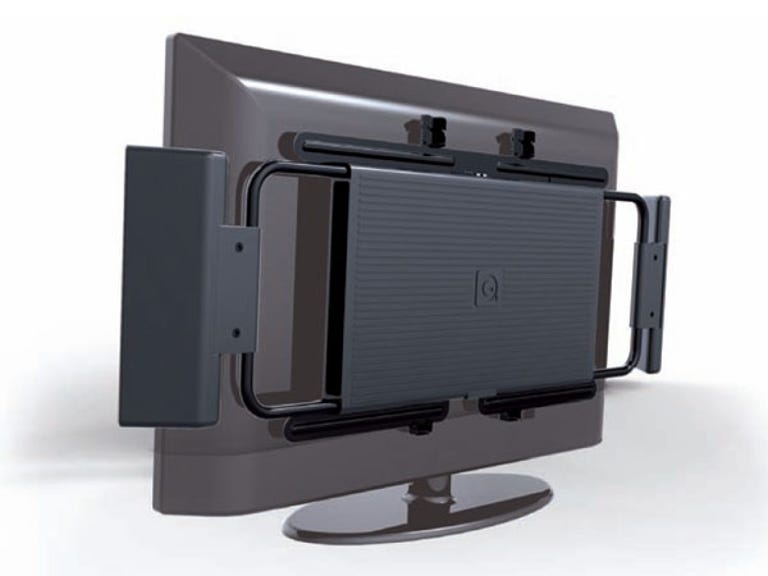 Why You Can Trust CNET
Why You Can Trust CNET Q Acoustics Q-TV2 review: Q Acoustics Q-TV2
The Q Acoustics Q-TV2 is a worthwhile upgrade for any avid television watcher, and it doesn't take up any extra room.
One of the most recent innovations in the field of home theatre has been the soundbar — a single speaker that sits underneath your TV that is designed to replace a 5.1 surround system. It's a concept pioneered by Yamaha several years ago and now offered by everyone from Marantz to Samsung to B&W. British manufacturer Q Acoustics has produced its own version of the soundbar in the past, but with the Q-TV it has produced something else entirely. Could this be the start of a new breed?
The Good
The Bad
The Bottom Line
Design and features
The Q-TV2 is a 2.1 system consisting of the ammo-box-like sub unit that attaches directly to the back of your TV, and the two speakers connected by adjustable arms which hug either side of your set. The unit is designed to accommodate between 30- and 42-inch televisions, and we were even able to fit it to a 46-inch Z5500 with a bit of shoe-horning — admittedly that model does have quite a thin bezel.
The speakers and sub use what the company calls Balanced Mode Radiators designed to offer a wider soundfield than conventional units. Theoretically, you shouldn't have to sit in the "sweet spot" directly between the speakers to get stereo sound. The unit has eight of these drivers, with a total of 100W of amplification.
Inputs are fairly limited, with two 3.5mm inputs, a single stereo RCA and an optical port. There's no source selector so you need to ensure that only one source is playing at once. The unit is relatively simple and so it lacks an on-screen display or other controls, though there is a three-step EQ and lip-sync compensation.
Though you'll be playing mostly analog devices through this device, the product information was a little vague about what formats the optical input supports. We'd suggest vanilla flavours of DTS, Dolby and PCM.
The Q-TV2 is different from a soundbar's because it actually attaches to the back of your television — utilising a bracket which screws into the wall-mount holes on the back of most sets. But how will you mount it on the wall then, you ask? Well, Q Acoustics supply two accessories, a wall mounting bracket (AU$129) and an extensible cantilever bracket (AU$449). If you have ever put together a piece of Ikea furniture then you will have no problem attaching the Q-TV2.
However, using a bracket does present its own challenges: it can block access to some ports, as we were unable to attach an antenna cable to the Sony Z5500 LCD — though, of course, the unit wasn't made for a TV of this size — and for a neater look you'll need to run any cables up between the unit and your TV.
Lastly, the unit comes with a simple remote which consists of only three buttons — volume up/down and mute.
The local distributor tells us that there are two further models coming soon, with a model fitting between 42- and 55-inch TVs in November and a smaller 15- to 30-inch model coming in March 2010.
Performance
As far as "quick and easy" additions to your big-screen TV go, the Q-TV2 isn't too bad. Putting it together is fairly simple, and within 10 minutes you will have an instant sound upgrade.
We played a variety of different material through the Q-TV and found there wasn't any particular genre or musical type it was most suited to — it's a true all-rounder. Sound quality was miles removed from the on-board sound of the Panasonic and Sony TVs we fitted it to — dialogue in particular was improved, with better intelligibility.
While there is sufficient bass, the relatively small size of the subwoofer means that you won't ever get gut-churning sound. Using the Oppo BDP-83 as a source we put on Mission Impossible III, and while the Q-TV lacks any sort of surround effects the movie was still enveloping, crisp and as exciting as ever. It can get plenty loud, but don't run it at full volume for an extended length of time or you'll find that the sound starts to fall apart.
The system sounded just as good with music as it did with movies and with Nick Cave's Red Right Hand the sound was well integrated and detailed, though bass lacked any sense of true bottom end. Put something more complicated into the system though and it can struggle. The absolutely insane tom-tom workout Atlas by Battles had some problems due to the amount of bottom end on offer. At high volumes the unit again became brittle — this is not the best machine to buy if you want a party starter.
To test the best placement of the unit we tried different configurations of the three-step EQ. We placed the Q Acoustics close to the wall, in a corner, and free from the wall — adjusting the three-way EQ to suit. We found that when the TV was close to the wall — say 30cm away — the "Corner" setting gave the unit its best sound. The Standard setting was a bit too boomy regardless of where we sat the TV, and the wall setting would probably only suit wall mounting.
Finally, despite the technology and thinking behind the Balanced Mode Radiators, we found that the Q-TV had an incredibly tight sweet spot. You need to sit dead centre of the two speakers otherwise you'll lose any real sense of stereo image.


